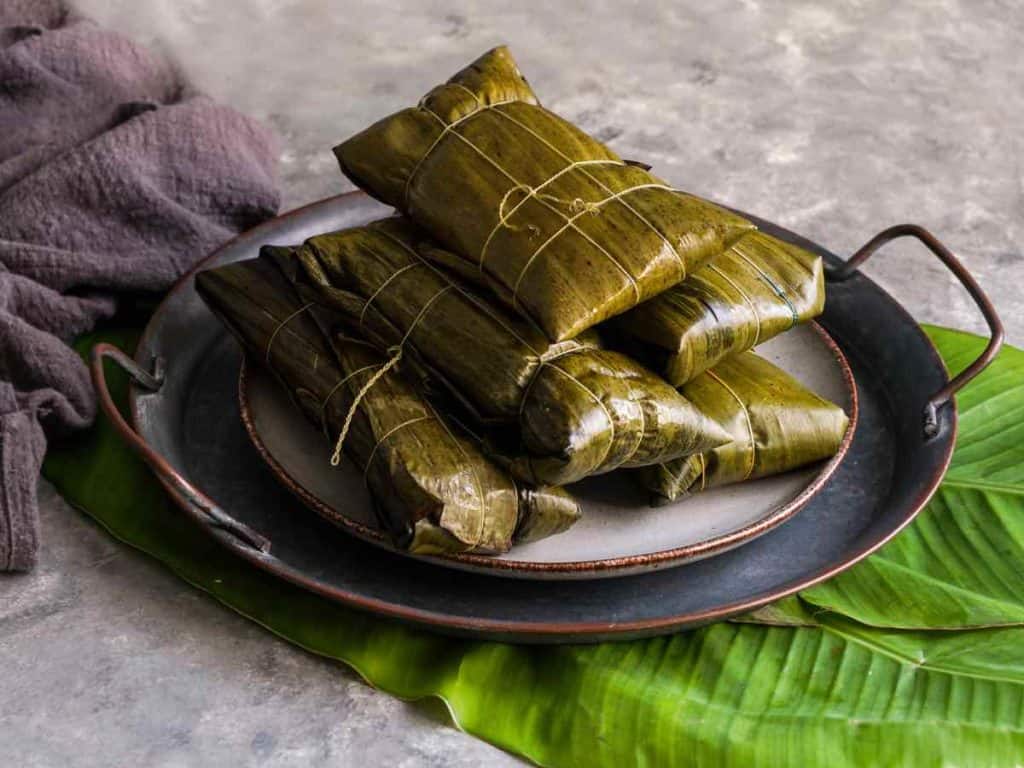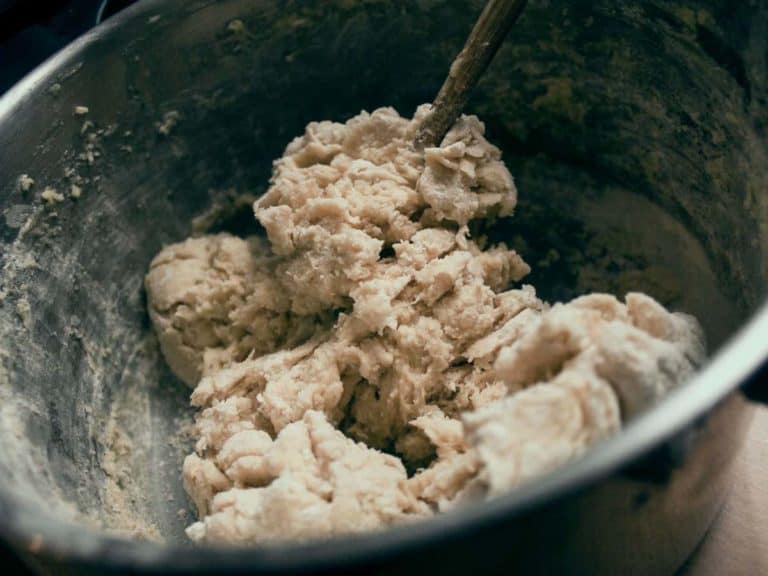How to Store Tamales: Cooked and Uncooked
Hola! Te amo tamales.
I love tamales too, and whenever I make them I end up making more than we can eat at one sitting. My stomach runs out of space before my appetite does, the way my poor brain runs out of Spanish before I’m done saying what I want to say.
Long story short, I always have leftover tamales, so the great challenge after every tamale dinner is storing the leftover tamales without losing their goodness.
To store cooked tamales first cool them down, then put in Ziplock bag, and refrigerate. Tamales can last between 4-7 days in the fridge or up to 6 months in the freezer. Frozen meat tamales have shorter lifespan: up to two months.
I take care to express as much air as possible from the Ziplock bags, and place a paper towel underneath each layer of tamales, to take away moisture.
This causes fewer and smaller, ice crystals to form in and on the tamales. This is important because ice crystals will ruin the tamales’ texture, causing them to come out mushy when reheated.
But is my way the only way?
Is it the best way?
Well, one afternoon I decided to exercise my Google-fu and find out. After sifting through a lot of cooking websites and asking fellow cooks,
I’ve found some methods and tips that seem to work well.
Let me share this list with you so you don’t have to look at all those maddening tamale pictures.
I just did, and now I’m hungry again!
Storing Cooked Tamales

Mom was right, the most important thing to do when storing cooked tamales is to cool them first. If your tamales remain warm enough for bacteria or molds to grow in them they will, even if refrigerated.
Once cooled, you can store cooked tamales in a Ziplock bag or plastic food keeper in the refrigerator, where they’ll last for 4 days to a week, or freeze them.
Frozen cooked tamales will last up to 6 months. However, if they’re made with meat, it’s better to consume them within just 2 months.
How Long Do Tamales Last Unrefrigerated?
Exactly how long your tamales will last depends very much on the weather at your place and whether you’re keeping them in an air-conditioned room or not.
A food industry standard is food should only be allowed to stand up to 4 hours at temperatures between 40 to 80 F, and no more than 90 minutes at temperatures between 80 to 130 F.
This is why it’s really important to cool uneaten fresh tamales as quickly as possible.
How to Cool Tamales for Storing
Cooked tamales should be prepared for storage by getting them to room temperature as quickly as possible.
Do this by arranging them in a single layer on a cooling rack or tray, preferably with space between each tamale.
Freshly steamed tamales retain heat well, so allow about an hour or two before transferring them to Ziplock bags or plastic tubs for storing.
Should Tamales be Stored Wrapped or Unwrapped?
While some advice that tamales should be unwrapped for freezing, as freezing ruins the corn husk wrappings, it doesn’t seem to be necessary.
I’ve gotten away with it, perhaps mainly because I try to sop away excess moisture with paper towels in the Ziplock bag.
The corn husks do soften on thawing though, so reheating the tamales by baking or frying may work better for you if you froze your tamales wrapped.
How to Reheat Frozen Tamales
The classic way to reheat tamales is to steam them. This best preserves their original taste and texture. However, other methods also work very well and even reinvent your leftover tamales for you, such as frying.
To reheat cooked tamales by steaming, thaw them if frozen, then arrange them in a steamer basket. Steam for 15-20 minutes. You can also steam tamales straight from the freezer, this takes about 30-35 minutes.
How to Thaw Frozen Tamales
It’s best to thaw frozen tamales overnight in the refrigerator until just defrosted, but still quite chilly to the touch.
Beyond this point, you will lose texture as the ice crystals in the masa melt and progressively turn the insides of your tamale to mush.
If they’re thawing too fast, you can put them in the chiller for a while to restore firmness.
How to Reheat Tamales in the Microwave
I used to believe the microwave was death for my tamales, after what it did to some other dough-based foods. It turns out there are two keys to successfully microwaving tamales.
First, to preserve moisture it’s best to wrap them in a moistened paper towel.
Second, microwave them in 15-30 second bursts at High, and turn them over after each burst.
How to Reheat Tamales in a Rice Cooker
An Asian friend has always made and re-warmed her tamales in her rice cooker.
While the typical family’s rice cooker won’t hold as many tamales as you might prefer to make, they’re ideal for cooking and reheating small batches.
To reheat tamales in a rice cooker, arrange your tamales in a single layer inside the rice cooker’s steamer basket, and fill the rice cooker’s bowl to about 2 inches short of its top. Set it to cook, checking every fifteen minutes or so if there’s still enough water in the bowl.
How to Reheat Tamales in a Crock-Pot
To reheat tamales in a crockpot, place them inside the pot with the open side up, sprinkle them with water, and set the cooker on High. Check the cooker every 30 minutes.
Don’t stuff the crockpot full of tamales – let them sit a little loosely, they’ll heat up faster that way.
How to Reheat Tamales in the Oven
Tamales can be reheated in the oven like pizza, but we have to preserve their moisture.
To do this, it’s best to wrap the tamales (whether still in their husks or not) with aluminum foil or baking paper before baking. Bake at 325 F for 20-25 minutes, turning the tamales midway during reheating.
How to Reheat Tamales in a Frying Pan
Tamales can be heated by frying, which has the extra benefit of adding extra flavor from the Maillard reaction. Heat a frying pan and add a little oil or butter.
Unwrap the tamales and fry each at low heat until heated through and the outsides lightly browned.
How to Deep-Fry Tamales
My Asian friend has a trick that ups her tamale game by leaps and bounds.
She doesn’t just fry her leftover tamales, she rolls them in panko and deep-fries them.
To get good results, you need to cut your tamales into smaller pieces, then follow the Japanese breading technique: dredge in flour, dip in beaten egg, then roll in panko before dropping into a hot fryer.
To do this with frozen tamales, it’s really important to thaw them until just thawed enough to cut. This keeps them from becoming mushy. Mushy tamales will just fall apart in your fryer.
Also, use a sharp knife as a blunt one will just squish and saw crumbs off your tamale. Prepare to work out a bit longer than usual once you’ve tasted this!
Can Tamales be Reheated in an Air Fryer?
An air fryer is nothing but a high-powered convection oven, which works by blasting your food with superheated air.
You can get away with air-frying your tamales, but you need to protect them from being dried out by the blast.
To reheat tamales in an air fryer, brush them with a little oil, or better yet wrap them individually in aluminum foil. Make sure to arrange them in the fryer basket with enough spaces between them for proper air circulation.
Can you make breaded fried tamales in an air fryer? Sadly, no. The air fryer’s fan will just blow most if not all your breading away, leaving you with a mostly naked and dry tamale, and more of a mess to clean afterward.
Storing Uncooked Tamales
Uncooked tamales can keep for 4 days to a week in the refrigerator, just like cooked tamales. However, if they contain meat, it’s better not to wait that long and cook them 48 hours after making. Uncooked tamales can also be frozen, and will last six months.
However, the consensus among Internet tamale cooks favors freezing tamales after cooking, not before.
Again, this is because of the effect of ice crystals on the texture of the dough.
Also, frozen raw ingredients in tamales may change in flavor over a long time in the freezer and during thawing.
How to Store Corn Husks for Tamales
If you bought dried corn husks for tamales, you may end up with some leftover corn husks after your tamalada, the traditional tamale-making get-together.
What can you do with these?
Dried corn husks, left dry, can last for up to a year. Just keep them well-sealed to keep out moisture.
If you don’t have too many leftovers, consider adding flavor and aroma to your tamales by lining the bottom of your steamer or pot with the leftover husks.
If there are just too many or won’t fit anymore in your pot, you may dry the husks if you’ve already soaked them in the sun or in the oven.
It’s best to pack these re-dried husks separately from the other unused but un-hydrated husks, so that in case your re-dried husks get mold it won’t affect the rest.
Check corn husks carefully for signs of mold before using. If you find any mold, you and your family will be safer if you just throw out the whole batch of husks and run to the store for new ones.
How to Tell if Tamales Have Spoiled
Spoiled tamales will have a sick, sour smell and may have spots of discoloration from bacteria and mold colonies. They may also exude a thin, sour fluid. Once this happens, it’s safest to consider the entire batch or container of tamales contaminated and throw them away.
To avoid spoilage of your stored tamales, make sure you cooled them sufficiently before refrigerating, kept them covered to keep off flies while on the shelf, and only thaw out what you will use immediately.





